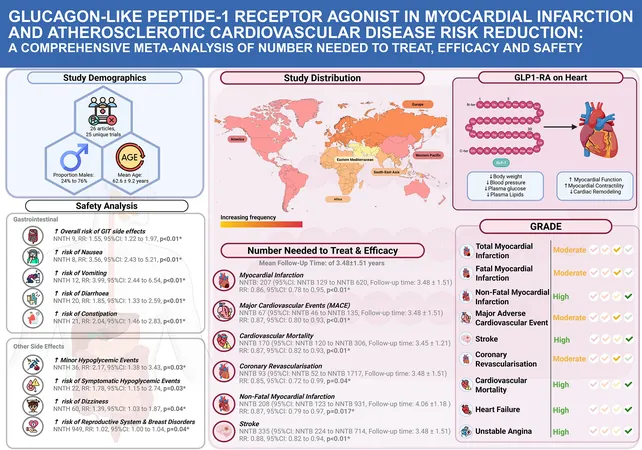
Revolutionary Findings: How GLP-1 Agonists Slash Heart Attack Risks!
2025-07-12
Author: Jia
Unveiling the Power of GLP-1 Agonists in Heart Health
In a groundbreaking systematic review and meta-analysis, researchers have uncovered compelling evidence on the benefits of glucagon-like peptide-1 receptor agonists (GLP-1RAs) in reducing myocardial infarction (MI) and atherosclerotic cardiovascular disease (ASCVD) risks. This extensive assessment, adhering to the PRISMA 2020 guidelines, scrutinized multiple randomized controlled trials (RCTs) to establish their efficacy in heart disease prevention.
Rigorous Methodology Ensures Comprehensive Review
With a meticulous search through Embase and Medline for relevant RCTs up to May 2025, the study evaluated only those trials where GLP-1RA treatment was compared to placebo or other diabetes medications. In total, 26 articles—from 25 unique trials—encompassing over 109,846 patients, were analyzed. This rigorous selection process ensured that only high-quality evidence contributed to the findings.
Fearless Against Heart Attacks: GLP-1 Agonists Make Their Mark
The results are impressive: GLP-1RAs are associated with a substantial 12% reduction in overall MI risk, translating to a number needed to treat (NNT) of 248 to prevent a single heart attack. For more significant outcomes, including major adverse cardiovascular events (MACE) and cardiovascular mortality, the NNT is even more favorable at 67.
Dive Into the Data: Efficacy and Risk Reduction Explained
This treasure trove of data indicates that GLP-1RAs significantly lower the rates of various cardiovascular incidents, including total MI (RR: 0.86) and non-fatal MI (RR: 0.87). When stacked against competing glucose-lowering agents, GLP-1RAs shine, cutting MACE rates drastically (RR: 0.73) and showcasing a remarkable reduction in cardiovascular deaths (RR: 0.43).
Addressing Safety: A Double-Edged Sword?
While these agents offer protective benefits, the analysis did highlight gastrointestinal side effects; patients experienced elevated nausea, vomiting, and diarrhea compared to placebo. However, the overall safety profile remains favorable, with only a modest increase in adverse events.
Unraveling Subgroup Insights: Who Benefits Most?
Notably, individuals with higher body mass index (BMI) showed an even more pronounced MI risk reduction, implying that GLP-1RAs could be particularly beneficial for overweight patients. Meanwhile, those with type 2 diabetes (T2DM) saw similar outcomes, although the effects appear to wane in populations with prior ASCVD.
The Bigger Picture: Implications for Clinical Practice
With current clinical guidelines advocating for GLP-1RA use among high-risk T2DM patients, this meta-analysis deepens the understanding of their role in ASCVD prevention. By elucidating the NNT and the overall efficacy and safety, it lays a solid foundation for incorporating GLP-1RAs into cardiovascular risk management strategies.
Conclusions: A Game Changer in Heart Health?
To sum it up, this comprehensive evaluation highlights GLP-1RAs as formidable allies in the fight against heart disease, particularly for patients battling obesity. With their potent risk-reducing capabilities and manageable safety profile, they solidify their status as essential tools in modern cardiology. As we look forward, cost-effectiveness studies and comparisons with emerging therapies will be crucial in fully understanding their potential in reshaping ASCVD management.




 Brasil (PT)
Brasil (PT)
 Canada (EN)
Canada (EN)
 Chile (ES)
Chile (ES)
 Česko (CS)
Česko (CS)
 대한민국 (KO)
대한민국 (KO)
 España (ES)
España (ES)
 France (FR)
France (FR)
 Hong Kong (EN)
Hong Kong (EN)
 Italia (IT)
Italia (IT)
 日本 (JA)
日本 (JA)
 Magyarország (HU)
Magyarország (HU)
 Norge (NO)
Norge (NO)
 Polska (PL)
Polska (PL)
 Schweiz (DE)
Schweiz (DE)
 Singapore (EN)
Singapore (EN)
 Sverige (SV)
Sverige (SV)
 Suomi (FI)
Suomi (FI)
 Türkiye (TR)
Türkiye (TR)
 الإمارات العربية المتحدة (AR)
الإمارات العربية المتحدة (AR)